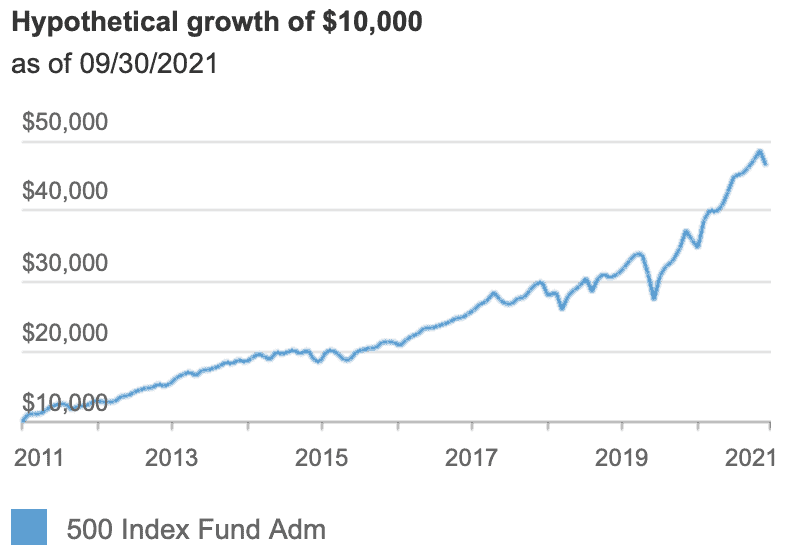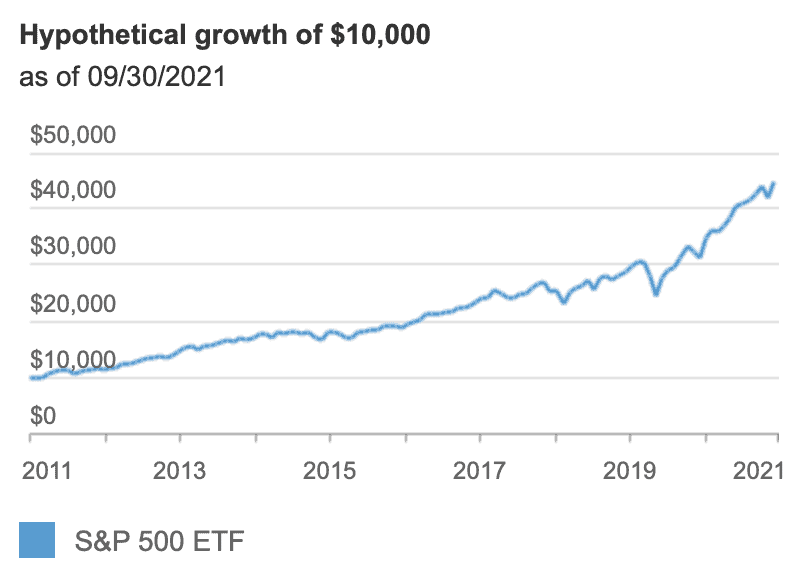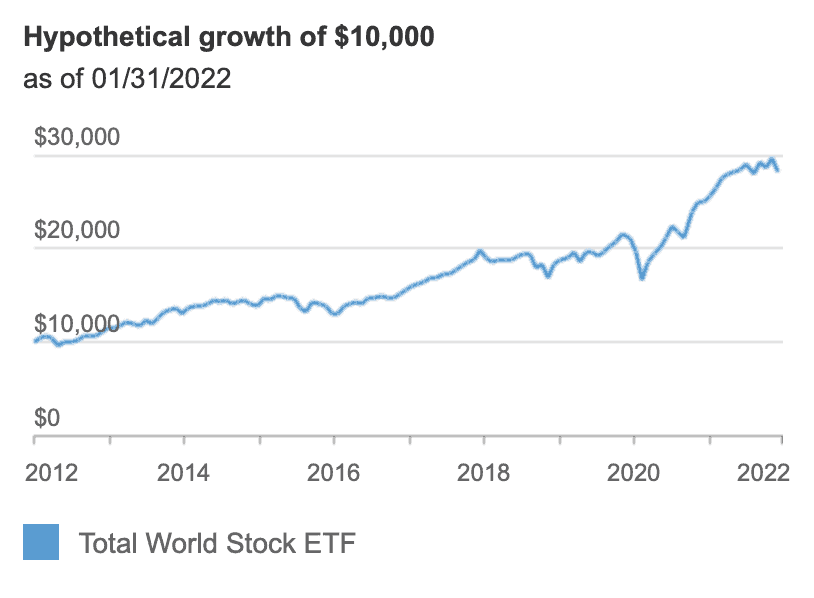Work shapes a third of our lives. If you’re unsure about how to genuinely feel […]
This is a comparison of VFIAX vs. VOO. Learn how to analyse which index fund is a better investment.
- The Vanguard 500 Index Fund Admiral Shares (VFIAX) is a mutual fund that aims to track the 500 largest US stocks.
- Vanguard S&P 500 ETF (VOO) is an ETF that seeks to track the performance of a benchmark index that measures the investment return of large-capitalization stocks.
To understand the difference between ETF and mutual funds, please read my article here.
Why should you consider VFIAX and VOO
Both are a low-cost way to gain diversified exposure to the U.S. equity market. The fund offers exposure to 500 of the largest U.S. companies, which span many different industries and account for about three-fourths of the U.S. stock market’s value.
VFIAX and VOO offer investors exposure to the 500 largest companies in the U.S. stock market. Compared to individual stocks that come with higher risks but higher returns, VFIAX and VOO spans the vast majority of the U.S. stock market from a market capitalization perspective.
Both VFIAX and VOO provide investors with a low-cost way to gain a broad and diversified exposure to the entire US stock market.
As the 500 Index Fund is broadly diversified within the large-capitalization market, it may be considered a core equity holding in your portfolio. This investment will enable you to get exposure to every US company within the stock index.
VFIAX vs VOO: Historical Performance
| VFIAX | VOO | |
| 1 Year Return | 29.53% | 29.51% |
| 3 Year Return | 15.47% | 15.46% |
| 5 Year Return | 16.34% | 16.34% |
| 10 Year Return | 16.08% | 16.07% |
Although both VFIAX and VOO have the same identical holdings, VFIAX performed slightly better than VOO in terms of overall performance.
VFIAX

VOO

VFIAX vs VOO: key findings and overlap
| VFIAX | VOO | |
| Description | Vanguard 500 Index Fund Admiral Shares | Vanguard S&P 500 ETF |
| Asset Class | Domestic Stock - General/ Large Blend | Domestic Stock - General/ Large Blend |
| Expense Ratio | 0.04% | 0.03% |
| Distributions | Quarterly | Quarterly |
| Minimum investment | 1 share | $3000 |
| Number of stocks | 510 | 510 |
| Fund total net assets | $770.2 billion | $770.2 billion |
| PE ratio | 24.3x | 24.3x |
| PB ratio | 4.3x | 4.3x |
| ROE | 20.7% | 20.7% |
| Earnings growth rate | 19.4% | 19.5% |
VFIAX vs VOO: Fund top holdings
| VFIAX / VOO | |
| Apple Inc | 6.08% |
| Microsoft Corp. | 5.80% |
| Alphabet Inc. | 3.92% |
| Amazon | 2.21% |
| 4.26% | |
| Tesla | 1.72% |
| NVIDIA | 1.41% |
| Berkshire Hathaway | 1.38% |
| JP Morgan Chase & Co | 1.34% |
VFIAX vs VOO: Sector breakdown
| VFIAX / VOO | |
| Communication services/ Telecommunications | 11.3% |
| Consumer Discretionary | 12.4% |
| Consumer Staples | 5.8% |
| Energy | 2.7% |
| Financials | 11.4% |
| Health Care | 13.3% |
| Industrials | 8% |
| Information Technology | 27.6% |
| Materials | 2.5% |
| Real Estate | 2.6% |
| Utilities | 2.4% |
Caveat
The key risk for these funds is the volatility that comes with its full exposure to the stock market. However, these index funds are suitable for investors with low risk tolerance.
How to buy
You can consider using moomoo/ TD Ameritrade/Tiger Brokers invest in NYSE.
Read the guides here: moomoo, Tiger Brokers
Differences between VFIAX vs. VOO
Liquidity
Trading of VFIAX is only available at the end of the trading day, while VOO that can be bought or sold throughout the trading day.
VOO provides real-time pricing since it’s an ETF, so you can see its price change throughout the day during trading hours.
Since VFIAX is a mutual fund, it isn’t priced until the trading day is over. You will not know the price until you’ve placed your trade. As Vanguard explains on their investment page:
“Regardless of what time of day you place your order, you’ll get the same price as everyone else who bought and sold that day. That price isn’t calculated until after the trading day is over.”
Share Price
VFIAX’s net asset value (NAV), or share price, is derived after the market closes. While for VOO, the share price changes according to the market's fluctuations.
Expense Ratio
VOO has a slightly lower expense ratio of 0.03% vs. VFIAX’s 0.04%. Although this isn’t necessarily a huge difference in cost, it will affect the performance of the index funds.
Minimum Fees
- VOO for the price of 1 share
- VFIAX with a minimum of $3,000
VFIAX vs. VOO summary – which one is better?
With VOO’s slightly lower expense ratio of 0.03% vs. VFIAX’s 0.04%, VOO appears to be better considering the holdings and other characteristics of the two are practically identical.
They both hold the 500 largest publicly traded companies in the U.S., which means they’ll provide identical investment returns. Either way, both offer exposure to the S&P 500 at a low fee.
Related article
VTI vs VOO: which index fund is a better investment (updated 2020)
Thank you for reading! Please like my Facebook page to get the latest updates. Please click here for Referral deals.






